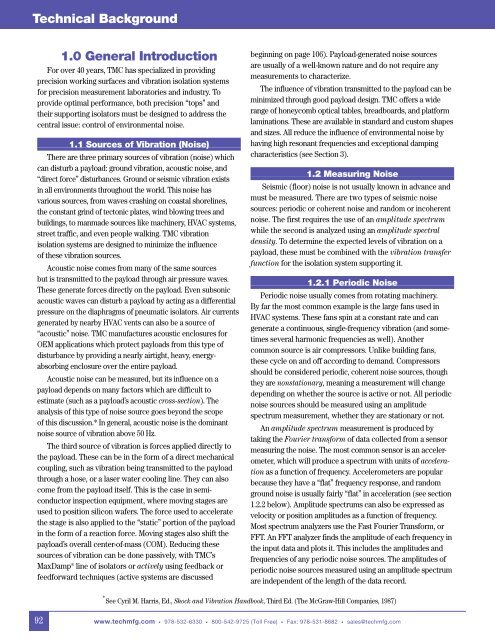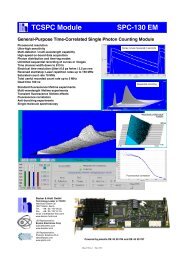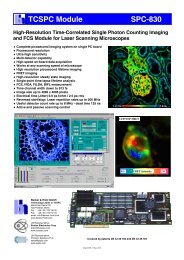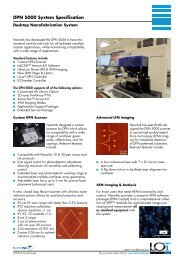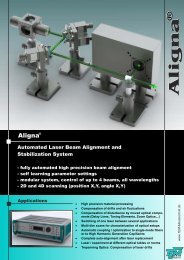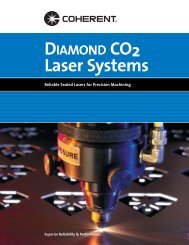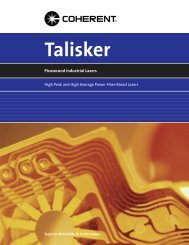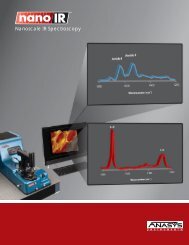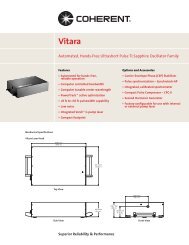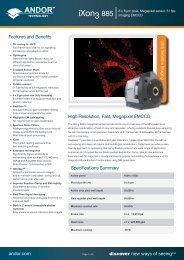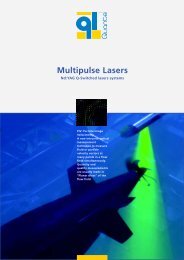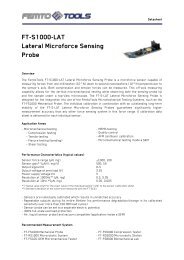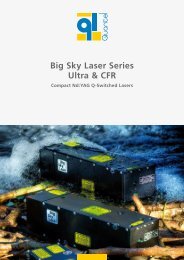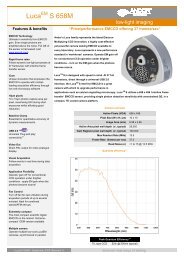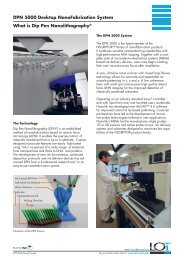Create successful ePaper yourself
Turn your PDF publications into a flip-book with our unique Google optimized e-Paper software.
Technical Background1.0 General IntroductionFor over 40 years, <strong>TMC</strong> has specialized in providingprecision working surfaces and vibration isolation systemsfor precision measurement laboratories and industry. Toprovide optimal performance, both precision “tops” andtheir supporting isolators must be designed to address thecentral issue: control of environmental noise.1.1 Sources of Vibration (Noise)There are three primary sources of vibration (noise) whichcan disturb a payload: ground vibration, acoustic noise, and“direct force” disturbances. Ground or seismic vibration existsin all environments throughout the world. This noise hasvarious sources, from waves crashing on coastal shorelines,the constant grind of tectonic plates, wind blowing trees andbuildings, to manmade sources like machinery, HVAC systems,street traffic, and even people walking. <strong>TMC</strong> vibrationisolation systems are designed to minimize the influenceof these vibration sources.Acoustic noise comes from many of the same sourcesbut is transmitted to the payload through air pressure waves.These generate forces directly on the payload. Even subsonicacoustic waves can disturb a payload by acting as a differentialpressure on the diaphragms of pneumatic isolators. Air currentsgenerated by nearby HVAC vents can also be a source of“acoustic” noise. <strong>TMC</strong> manufactures acoustic enclosures forOEM applications which protect payloads from this type ofdisturbance by providing a nearly airtight, heavy, energyabsorbingenclosure over the entire payload.Acoustic noise can be measured, but its influence on apayload dep ends on many factors which are difficult toestimate (such as a payload’s acoustic cross-section). Theanalysis of this type of noise source goes beyond the scopeof this discussion.* In general, acoustic noise is the dominantnoise source of vibration above 50 Hz.The third source of vibration is forces applied directly tothe payload. These can be in the form of a direct mechanicalcoupling, such as vibration being transmitted to the payloadthrough a hose, or a laser water cooling line. They can alsocome from the payload itself. This is the case in semi -conductor inspection equipment, where moving stages areused to position silicon wafers. The force used to acceleratethe stage is also applied to the “static” portion of the payloadin the form of a reaction force. Moving stages also shift thepayload’s overall center-of-mass (COM). Reducing thesesources of vibration can be done passively, with <strong>TMC</strong>’sMaxDamp ® line of isolators or actively using feedback orfeedforward techniques (active systems are discussedbeginning on page 106). Payload-generated noise sourcesare usually of a well-known nature and do not require anymeasurements to characterize.The influence of vibration transmitted to the payload can bemin imized through good payload design. <strong>TMC</strong> offers a widerange of honey comb optical tables, breadboards, and platformlaminations. These are available in standard and custom shapesand sizes. All reduce the influence of environmental noise byhaving high resonant freq uen cies and exceptional dampingcharacteristics (see Section 3).1.2 Measuring NoiseSeismic (floor) noise is not usually known in advance andmust be measured. There are two types of seismic noisesources: periodic or coherent noise and random or incoherentnoise. The first requires the use of an amplitude spectrumwhile the second is analyzed using an amplitude spectraldensity. To determine the expected levels of vibration on apayload, these must be combined with the vibration transferfunction for the isolation system supporting it.1.2.1 Periodic NoisePeriodic noise usually comes from rotating machinery.By far the most common example is the large fans used inHVAC systems. These fans spin at a constant rate and cangenerate a continuous, single-frequency vibration (and sometimesseveral harmonic frequencies as well). Anothercommon source is air compressors. Unlike building fans,these cycle on and off according to demand. Compressorsshould be considered periodic, coherent noise sources, thoughthey are nonstationary, meaning a measurement will changedepending on whether the source is active or not. All periodicnoise sources should be measured using an amplitudespectrum measurement, whether they are stationary or not.An amplitude spectrum measurement is produced bytaking the Fourier transform of data collected from a sensormeasuring the noise. The most common sensor is an accelerometer,which will produce a spectrum with units of accelerationas a function of frequency. Accel erometers are popularbecause they have a “flat” frequency response, and randomground noise is usually fairly “flat” in acceleration (see section1.2.2 below). Amplitude spectrums can also be expressed asvelocity or position amplitudes as a function of frequency.Most spectrum an al y zers use the Fast Fourier Transform, orFFT. An FFT analyzer finds the amplitude of each frequency inthe input data and plots it. This includes the amplitudes andfrequencies of any periodic noise sources. The amplitudes ofperiodic noise sources measured using an amplitude spectrumare independent of the length of the data record.* See Cyril M. Harris, Ed., Shock and Vibration Handbook, Third Ed. (The McGraw-Hill Companies, 1987)92 www.techmfg.com • 978-532-6330 • 800-542-9725 (Toll Free) • Fax: 978-531-8682 • sales@techmfg.com


